Analysis of GovDept Enterprise Architecture Case Study
VerifiedAdded on 2022/09/12
|13
|2904
|26
Case Study
AI Summary
This case study examines the Enterprise Architecture (EA) of GovDept, a mid-sized governmental department. The analysis covers various aspects, including a roadmap of projects, IT roles within the organization, and the EA artifacts developed by consultants. The study details the taxonomy of documentation, the chosen coordinating operating model, and the roles of standards and landscapes in EA implementation. It also outlines specific IT initiatives planned to improve business units and customer service. The case study considers the EA artifacts, principles, technology reference models, guidelines, business capability models, and roadmaps. It concludes by describing visions for the successful implementation of these artifacts, aiming for improved business outcomes and customer satisfaction. This assignment provides a comprehensive overview of EA implementation within a governmental context, addressing challenges related to IT adoption and legacy systems.
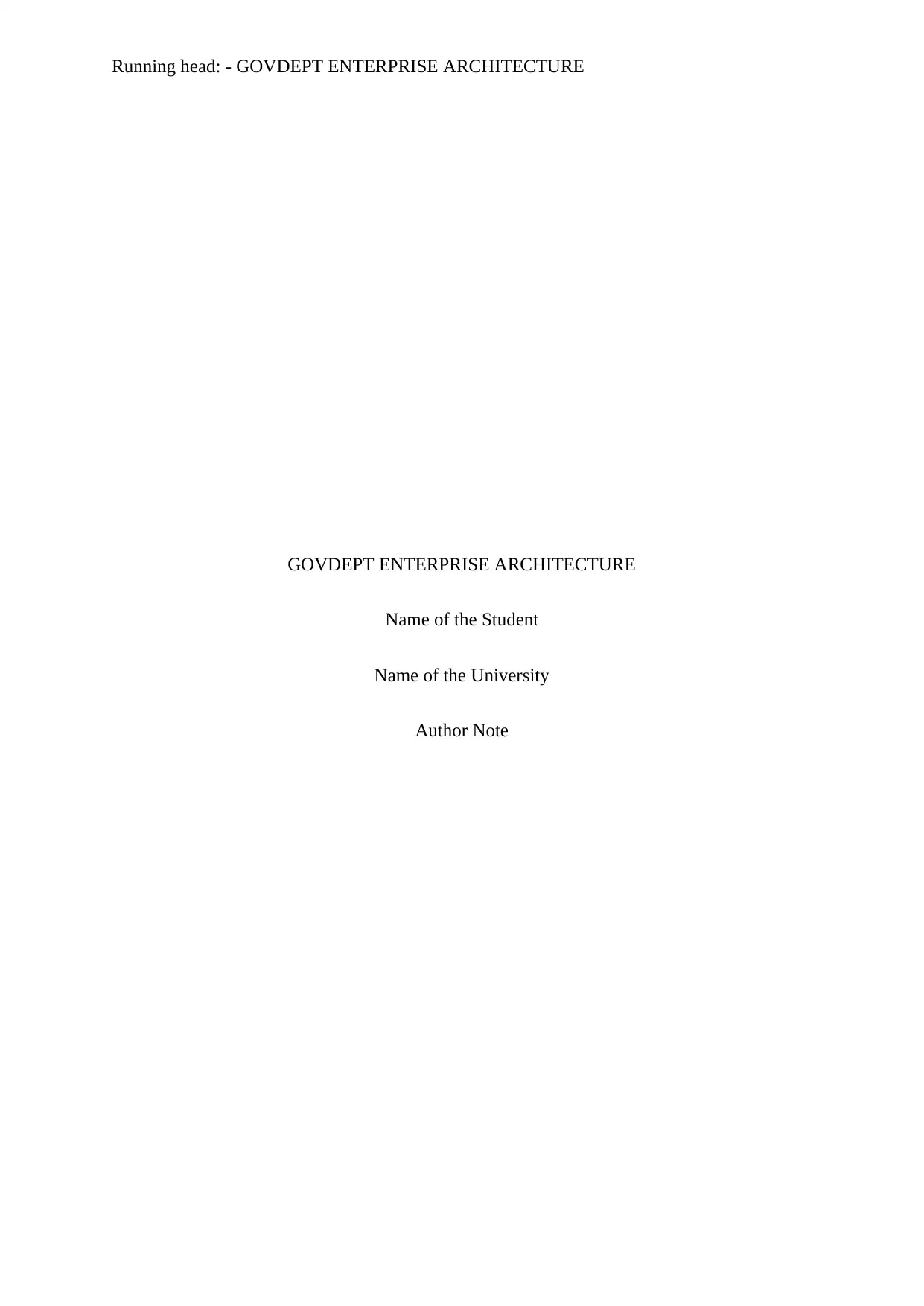
Running head: - GOVDEPT ENTERPRISE ARCHITECTURE
GOVDEPT ENTERPRISE ARCHITECTURE
Name of the Student
Name of the University
Author Note
GOVDEPT ENTERPRISE ARCHITECTURE
Name of the Student
Name of the University
Author Note
Paraphrase This Document
Need a fresh take? Get an instant paraphrase of this document with our AI Paraphraser
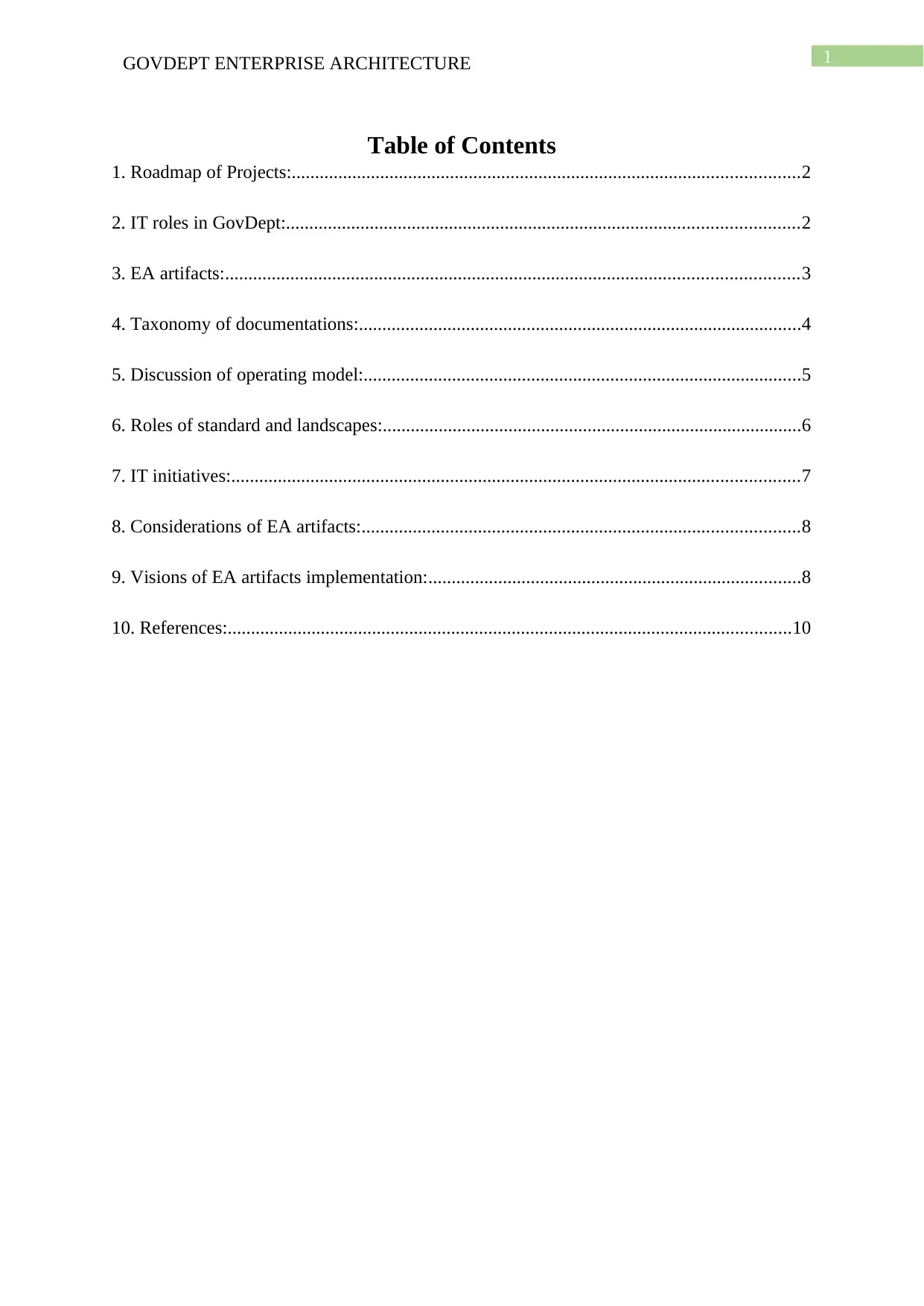
1GOVDEPT ENTERPRISE ARCHITECTURE
Table of Contents
1. Roadmap of Projects:.............................................................................................................2
2. IT roles in GovDept:..............................................................................................................2
3. EA artifacts:...........................................................................................................................3
4. Taxonomy of documentations:...............................................................................................4
5. Discussion of operating model:..............................................................................................5
6. Roles of standard and landscapes:..........................................................................................6
7. IT initiatives:..........................................................................................................................7
8. Considerations of EA artifacts:..............................................................................................8
9. Visions of EA artifacts implementation:................................................................................8
10. References:.........................................................................................................................10
Table of Contents
1. Roadmap of Projects:.............................................................................................................2
2. IT roles in GovDept:..............................................................................................................2
3. EA artifacts:...........................................................................................................................3
4. Taxonomy of documentations:...............................................................................................4
5. Discussion of operating model:..............................................................................................5
6. Roles of standard and landscapes:..........................................................................................6
7. IT initiatives:..........................................................................................................................7
8. Considerations of EA artifacts:..............................................................................................8
9. Visions of EA artifacts implementation:................................................................................8
10. References:.........................................................................................................................10
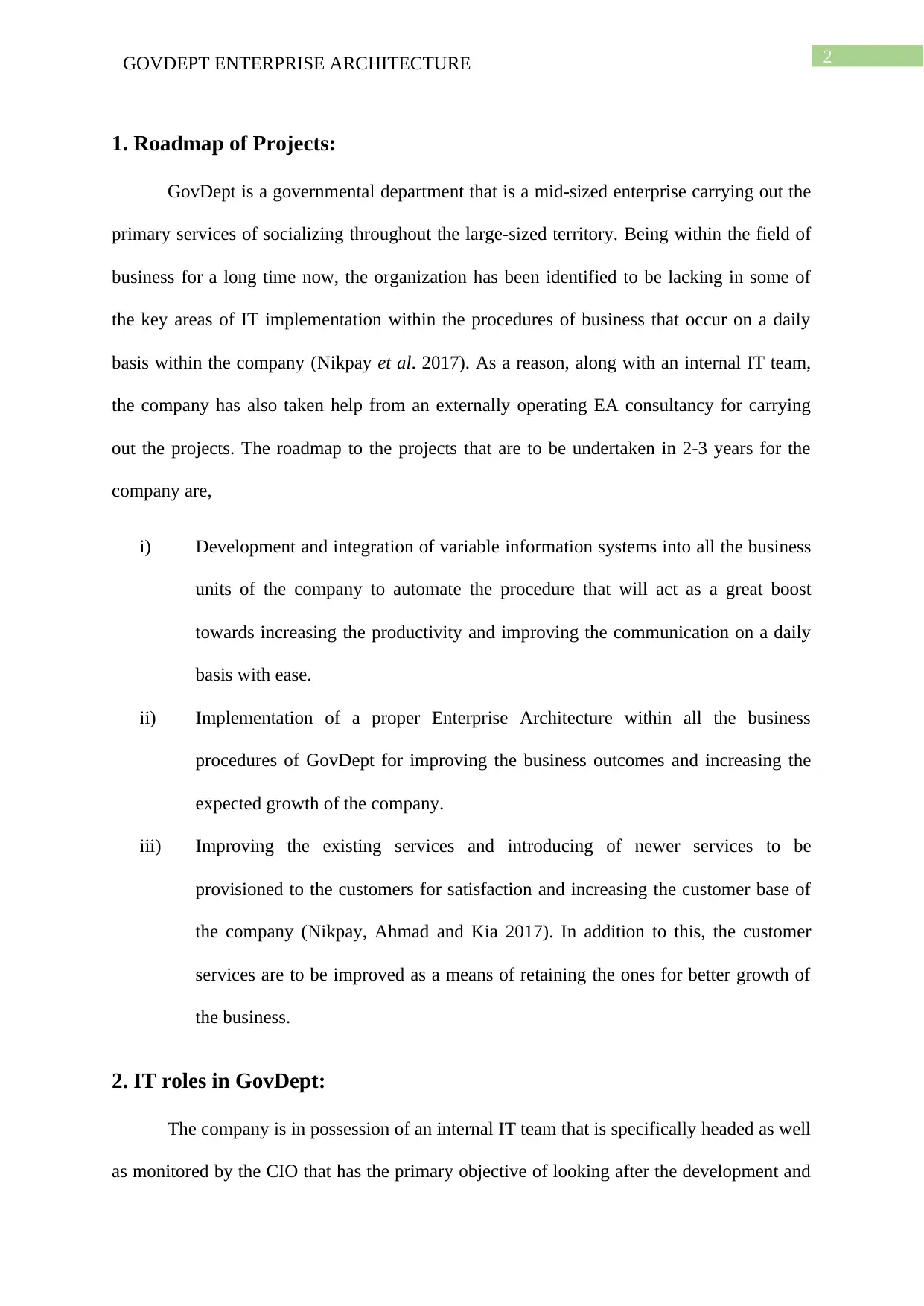
2GOVDEPT ENTERPRISE ARCHITECTURE
1. Roadmap of Projects:
GovDept is a governmental department that is a mid-sized enterprise carrying out the
primary services of socializing throughout the large-sized territory. Being within the field of
business for a long time now, the organization has been identified to be lacking in some of
the key areas of IT implementation within the procedures of business that occur on a daily
basis within the company (Nikpay et al. 2017). As a reason, along with an internal IT team,
the company has also taken help from an externally operating EA consultancy for carrying
out the projects. The roadmap to the projects that are to be undertaken in 2-3 years for the
company are,
i) Development and integration of variable information systems into all the business
units of the company to automate the procedure that will act as a great boost
towards increasing the productivity and improving the communication on a daily
basis with ease.
ii) Implementation of a proper Enterprise Architecture within all the business
procedures of GovDept for improving the business outcomes and increasing the
expected growth of the company.
iii) Improving the existing services and introducing of newer services to be
provisioned to the customers for satisfaction and increasing the customer base of
the company (Nikpay, Ahmad and Kia 2017). In addition to this, the customer
services are to be improved as a means of retaining the ones for better growth of
the business.
2. IT roles in GovDept:
The company is in possession of an internal IT team that is specifically headed as well
as monitored by the CIO that has the primary objective of looking after the development and
1. Roadmap of Projects:
GovDept is a governmental department that is a mid-sized enterprise carrying out the
primary services of socializing throughout the large-sized territory. Being within the field of
business for a long time now, the organization has been identified to be lacking in some of
the key areas of IT implementation within the procedures of business that occur on a daily
basis within the company (Nikpay et al. 2017). As a reason, along with an internal IT team,
the company has also taken help from an externally operating EA consultancy for carrying
out the projects. The roadmap to the projects that are to be undertaken in 2-3 years for the
company are,
i) Development and integration of variable information systems into all the business
units of the company to automate the procedure that will act as a great boost
towards increasing the productivity and improving the communication on a daily
basis with ease.
ii) Implementation of a proper Enterprise Architecture within all the business
procedures of GovDept for improving the business outcomes and increasing the
expected growth of the company.
iii) Improving the existing services and introducing of newer services to be
provisioned to the customers for satisfaction and increasing the customer base of
the company (Nikpay, Ahmad and Kia 2017). In addition to this, the customer
services are to be improved as a means of retaining the ones for better growth of
the business.
2. IT roles in GovDept:
The company is in possession of an internal IT team that is specifically headed as well
as monitored by the CIO that has the primary objective of looking after the development and
⊘ This is a preview!⊘
Do you want full access?
Subscribe today to unlock all pages.

Trusted by 1+ million students worldwide
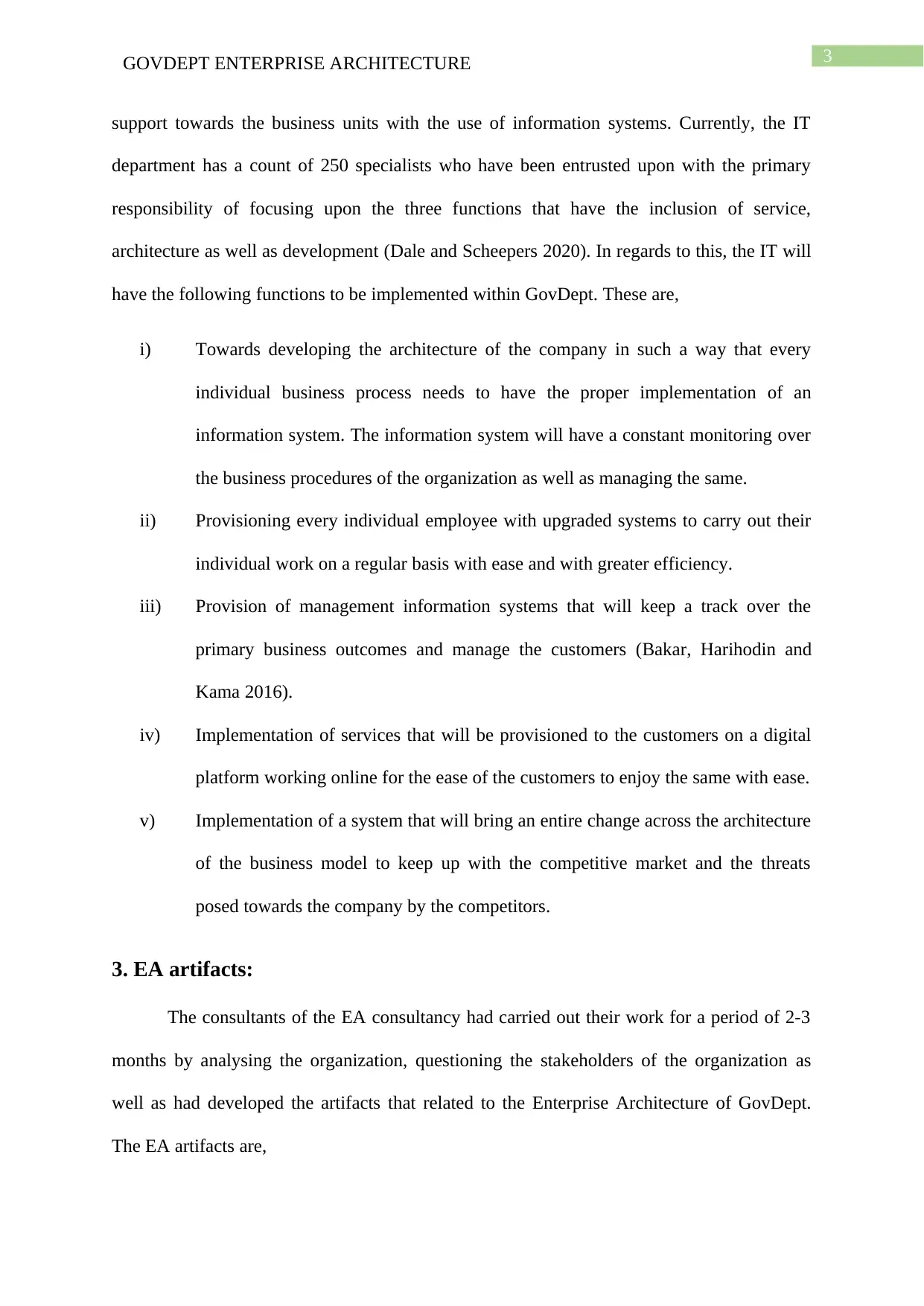
3GOVDEPT ENTERPRISE ARCHITECTURE
support towards the business units with the use of information systems. Currently, the IT
department has a count of 250 specialists who have been entrusted upon with the primary
responsibility of focusing upon the three functions that have the inclusion of service,
architecture as well as development (Dale and Scheepers 2020). In regards to this, the IT will
have the following functions to be implemented within GovDept. These are,
i) Towards developing the architecture of the company in such a way that every
individual business process needs to have the proper implementation of an
information system. The information system will have a constant monitoring over
the business procedures of the organization as well as managing the same.
ii) Provisioning every individual employee with upgraded systems to carry out their
individual work on a regular basis with ease and with greater efficiency.
iii) Provision of management information systems that will keep a track over the
primary business outcomes and manage the customers (Bakar, Harihodin and
Kama 2016).
iv) Implementation of services that will be provisioned to the customers on a digital
platform working online for the ease of the customers to enjoy the same with ease.
v) Implementation of a system that will bring an entire change across the architecture
of the business model to keep up with the competitive market and the threats
posed towards the company by the competitors.
3. EA artifacts:
The consultants of the EA consultancy had carried out their work for a period of 2-3
months by analysing the organization, questioning the stakeholders of the organization as
well as had developed the artifacts that related to the Enterprise Architecture of GovDept.
The EA artifacts are,
support towards the business units with the use of information systems. Currently, the IT
department has a count of 250 specialists who have been entrusted upon with the primary
responsibility of focusing upon the three functions that have the inclusion of service,
architecture as well as development (Dale and Scheepers 2020). In regards to this, the IT will
have the following functions to be implemented within GovDept. These are,
i) Towards developing the architecture of the company in such a way that every
individual business process needs to have the proper implementation of an
information system. The information system will have a constant monitoring over
the business procedures of the organization as well as managing the same.
ii) Provisioning every individual employee with upgraded systems to carry out their
individual work on a regular basis with ease and with greater efficiency.
iii) Provision of management information systems that will keep a track over the
primary business outcomes and manage the customers (Bakar, Harihodin and
Kama 2016).
iv) Implementation of services that will be provisioned to the customers on a digital
platform working online for the ease of the customers to enjoy the same with ease.
v) Implementation of a system that will bring an entire change across the architecture
of the business model to keep up with the competitive market and the threats
posed towards the company by the competitors.
3. EA artifacts:
The consultants of the EA consultancy had carried out their work for a period of 2-3
months by analysing the organization, questioning the stakeholders of the organization as
well as had developed the artifacts that related to the Enterprise Architecture of GovDept.
The EA artifacts are,
Paraphrase This Document
Need a fresh take? Get an instant paraphrase of this document with our AI Paraphraser
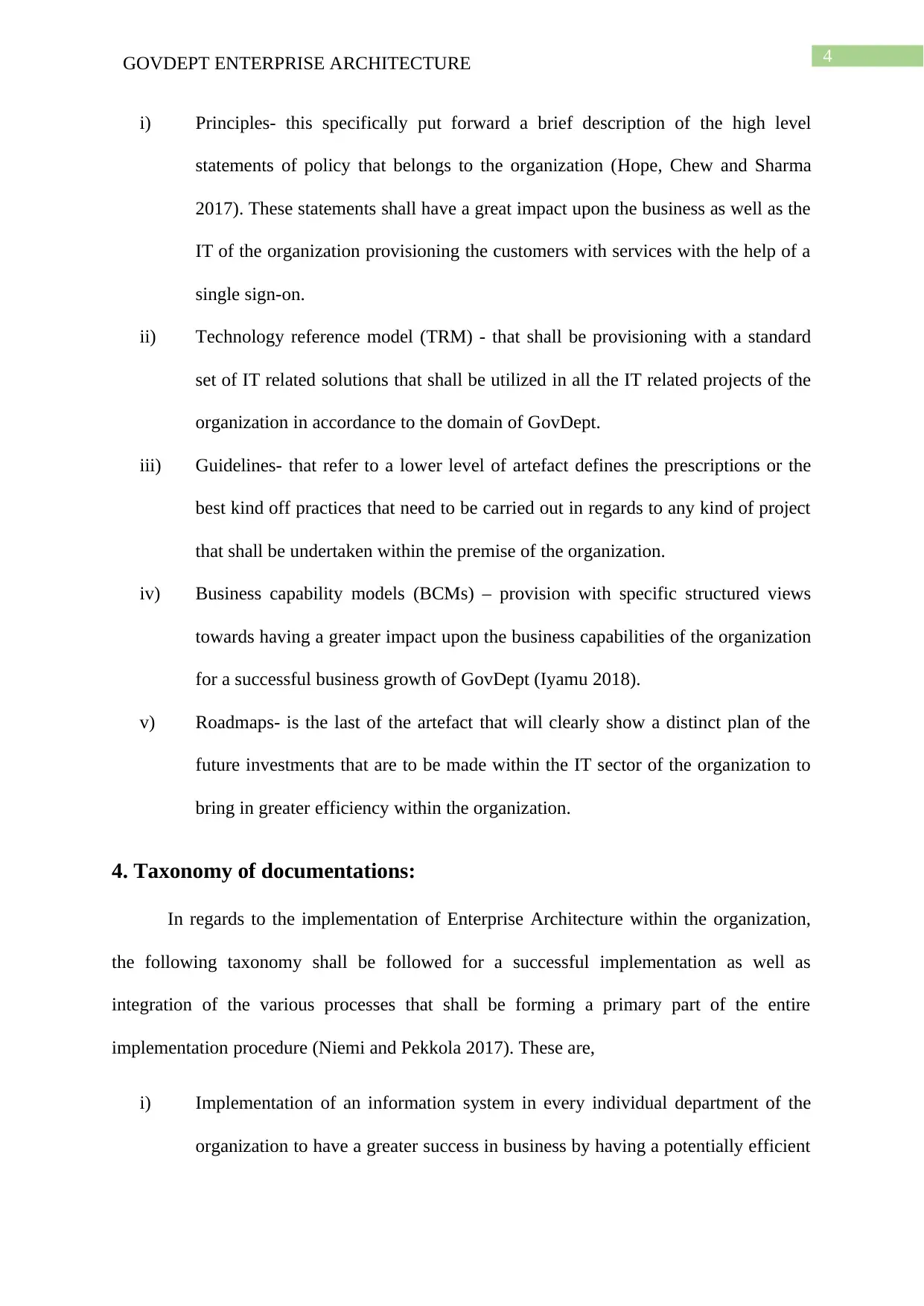
4GOVDEPT ENTERPRISE ARCHITECTURE
i) Principles- this specifically put forward a brief description of the high level
statements of policy that belongs to the organization (Hope, Chew and Sharma
2017). These statements shall have a great impact upon the business as well as the
IT of the organization provisioning the customers with services with the help of a
single sign-on.
ii) Technology reference model (TRM) - that shall be provisioning with a standard
set of IT related solutions that shall be utilized in all the IT related projects of the
organization in accordance to the domain of GovDept.
iii) Guidelines- that refer to a lower level of artefact defines the prescriptions or the
best kind off practices that need to be carried out in regards to any kind of project
that shall be undertaken within the premise of the organization.
iv) Business capability models (BCMs) – provision with specific structured views
towards having a greater impact upon the business capabilities of the organization
for a successful business growth of GovDept (Iyamu 2018).
v) Roadmaps- is the last of the artefact that will clearly show a distinct plan of the
future investments that are to be made within the IT sector of the organization to
bring in greater efficiency within the organization.
4. Taxonomy of documentations:
In regards to the implementation of Enterprise Architecture within the organization,
the following taxonomy shall be followed for a successful implementation as well as
integration of the various processes that shall be forming a primary part of the entire
implementation procedure (Niemi and Pekkola 2017). These are,
i) Implementation of an information system in every individual department of the
organization to have a greater success in business by having a potentially efficient
i) Principles- this specifically put forward a brief description of the high level
statements of policy that belongs to the organization (Hope, Chew and Sharma
2017). These statements shall have a great impact upon the business as well as the
IT of the organization provisioning the customers with services with the help of a
single sign-on.
ii) Technology reference model (TRM) - that shall be provisioning with a standard
set of IT related solutions that shall be utilized in all the IT related projects of the
organization in accordance to the domain of GovDept.
iii) Guidelines- that refer to a lower level of artefact defines the prescriptions or the
best kind off practices that need to be carried out in regards to any kind of project
that shall be undertaken within the premise of the organization.
iv) Business capability models (BCMs) – provision with specific structured views
towards having a greater impact upon the business capabilities of the organization
for a successful business growth of GovDept (Iyamu 2018).
v) Roadmaps- is the last of the artefact that will clearly show a distinct plan of the
future investments that are to be made within the IT sector of the organization to
bring in greater efficiency within the organization.
4. Taxonomy of documentations:
In regards to the implementation of Enterprise Architecture within the organization,
the following taxonomy shall be followed for a successful implementation as well as
integration of the various processes that shall be forming a primary part of the entire
implementation procedure (Niemi and Pekkola 2017). These are,
i) Implementation of an information system in every individual department of the
organization to have a greater success in business by having a potentially efficient
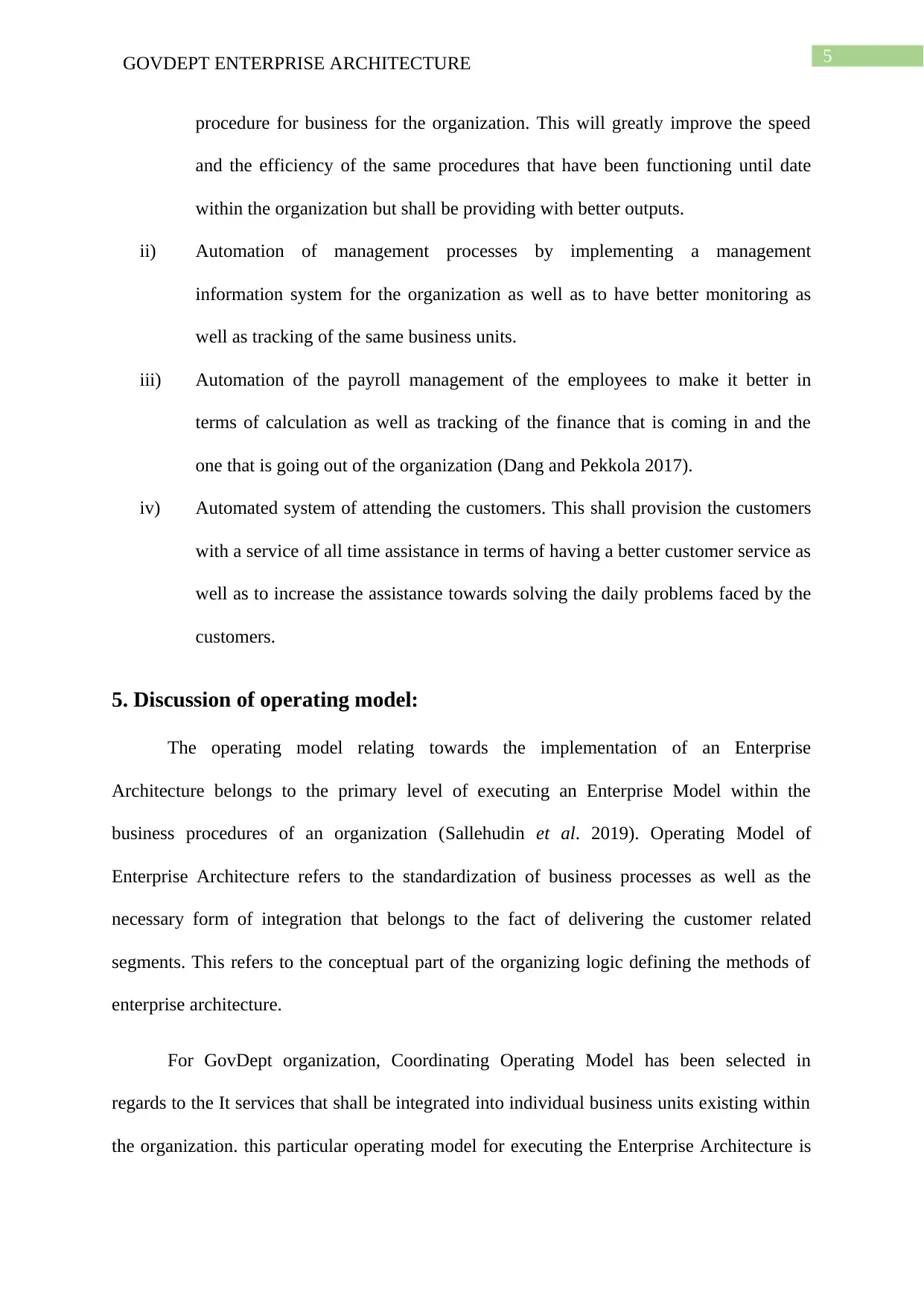
5GOVDEPT ENTERPRISE ARCHITECTURE
procedure for business for the organization. This will greatly improve the speed
and the efficiency of the same procedures that have been functioning until date
within the organization but shall be providing with better outputs.
ii) Automation of management processes by implementing a management
information system for the organization as well as to have better monitoring as
well as tracking of the same business units.
iii) Automation of the payroll management of the employees to make it better in
terms of calculation as well as tracking of the finance that is coming in and the
one that is going out of the organization (Dang and Pekkola 2017).
iv) Automated system of attending the customers. This shall provision the customers
with a service of all time assistance in terms of having a better customer service as
well as to increase the assistance towards solving the daily problems faced by the
customers.
5. Discussion of operating model:
The operating model relating towards the implementation of an Enterprise
Architecture belongs to the primary level of executing an Enterprise Model within the
business procedures of an organization (Sallehudin et al. 2019). Operating Model of
Enterprise Architecture refers to the standardization of business processes as well as the
necessary form of integration that belongs to the fact of delivering the customer related
segments. This refers to the conceptual part of the organizing logic defining the methods of
enterprise architecture.
For GovDept organization, Coordinating Operating Model has been selected in
regards to the It services that shall be integrated into individual business units existing within
the organization. this particular operating model for executing the Enterprise Architecture is
procedure for business for the organization. This will greatly improve the speed
and the efficiency of the same procedures that have been functioning until date
within the organization but shall be providing with better outputs.
ii) Automation of management processes by implementing a management
information system for the organization as well as to have better monitoring as
well as tracking of the same business units.
iii) Automation of the payroll management of the employees to make it better in
terms of calculation as well as tracking of the finance that is coming in and the
one that is going out of the organization (Dang and Pekkola 2017).
iv) Automated system of attending the customers. This shall provision the customers
with a service of all time assistance in terms of having a better customer service as
well as to increase the assistance towards solving the daily problems faced by the
customers.
5. Discussion of operating model:
The operating model relating towards the implementation of an Enterprise
Architecture belongs to the primary level of executing an Enterprise Model within the
business procedures of an organization (Sallehudin et al. 2019). Operating Model of
Enterprise Architecture refers to the standardization of business processes as well as the
necessary form of integration that belongs to the fact of delivering the customer related
segments. This refers to the conceptual part of the organizing logic defining the methods of
enterprise architecture.
For GovDept organization, Coordinating Operating Model has been selected in
regards to the It services that shall be integrated into individual business units existing within
the organization. this particular operating model for executing the Enterprise Architecture is
⊘ This is a preview!⊘
Do you want full access?
Subscribe today to unlock all pages.

Trusted by 1+ million students worldwide
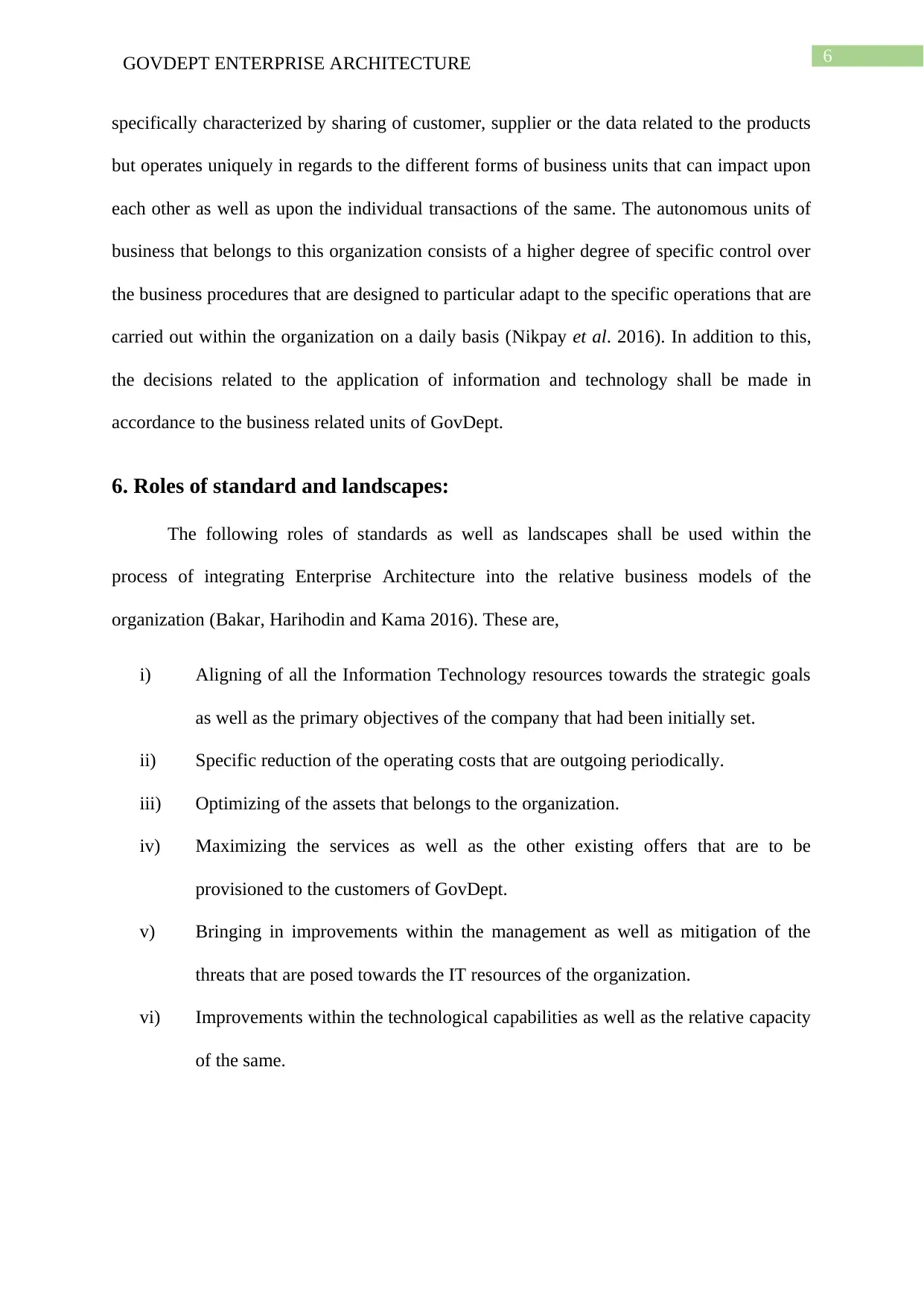
6GOVDEPT ENTERPRISE ARCHITECTURE
specifically characterized by sharing of customer, supplier or the data related to the products
but operates uniquely in regards to the different forms of business units that can impact upon
each other as well as upon the individual transactions of the same. The autonomous units of
business that belongs to this organization consists of a higher degree of specific control over
the business procedures that are designed to particular adapt to the specific operations that are
carried out within the organization on a daily basis (Nikpay et al. 2016). In addition to this,
the decisions related to the application of information and technology shall be made in
accordance to the business related units of GovDept.
6. Roles of standard and landscapes:
The following roles of standards as well as landscapes shall be used within the
process of integrating Enterprise Architecture into the relative business models of the
organization (Bakar, Harihodin and Kama 2016). These are,
i) Aligning of all the Information Technology resources towards the strategic goals
as well as the primary objectives of the company that had been initially set.
ii) Specific reduction of the operating costs that are outgoing periodically.
iii) Optimizing of the assets that belongs to the organization.
iv) Maximizing the services as well as the other existing offers that are to be
provisioned to the customers of GovDept.
v) Bringing in improvements within the management as well as mitigation of the
threats that are posed towards the IT resources of the organization.
vi) Improvements within the technological capabilities as well as the relative capacity
of the same.
specifically characterized by sharing of customer, supplier or the data related to the products
but operates uniquely in regards to the different forms of business units that can impact upon
each other as well as upon the individual transactions of the same. The autonomous units of
business that belongs to this organization consists of a higher degree of specific control over
the business procedures that are designed to particular adapt to the specific operations that are
carried out within the organization on a daily basis (Nikpay et al. 2016). In addition to this,
the decisions related to the application of information and technology shall be made in
accordance to the business related units of GovDept.
6. Roles of standard and landscapes:
The following roles of standards as well as landscapes shall be used within the
process of integrating Enterprise Architecture into the relative business models of the
organization (Bakar, Harihodin and Kama 2016). These are,
i) Aligning of all the Information Technology resources towards the strategic goals
as well as the primary objectives of the company that had been initially set.
ii) Specific reduction of the operating costs that are outgoing periodically.
iii) Optimizing of the assets that belongs to the organization.
iv) Maximizing the services as well as the other existing offers that are to be
provisioned to the customers of GovDept.
v) Bringing in improvements within the management as well as mitigation of the
threats that are posed towards the IT resources of the organization.
vi) Improvements within the technological capabilities as well as the relative capacity
of the same.
Paraphrase This Document
Need a fresh take? Get an instant paraphrase of this document with our AI Paraphraser
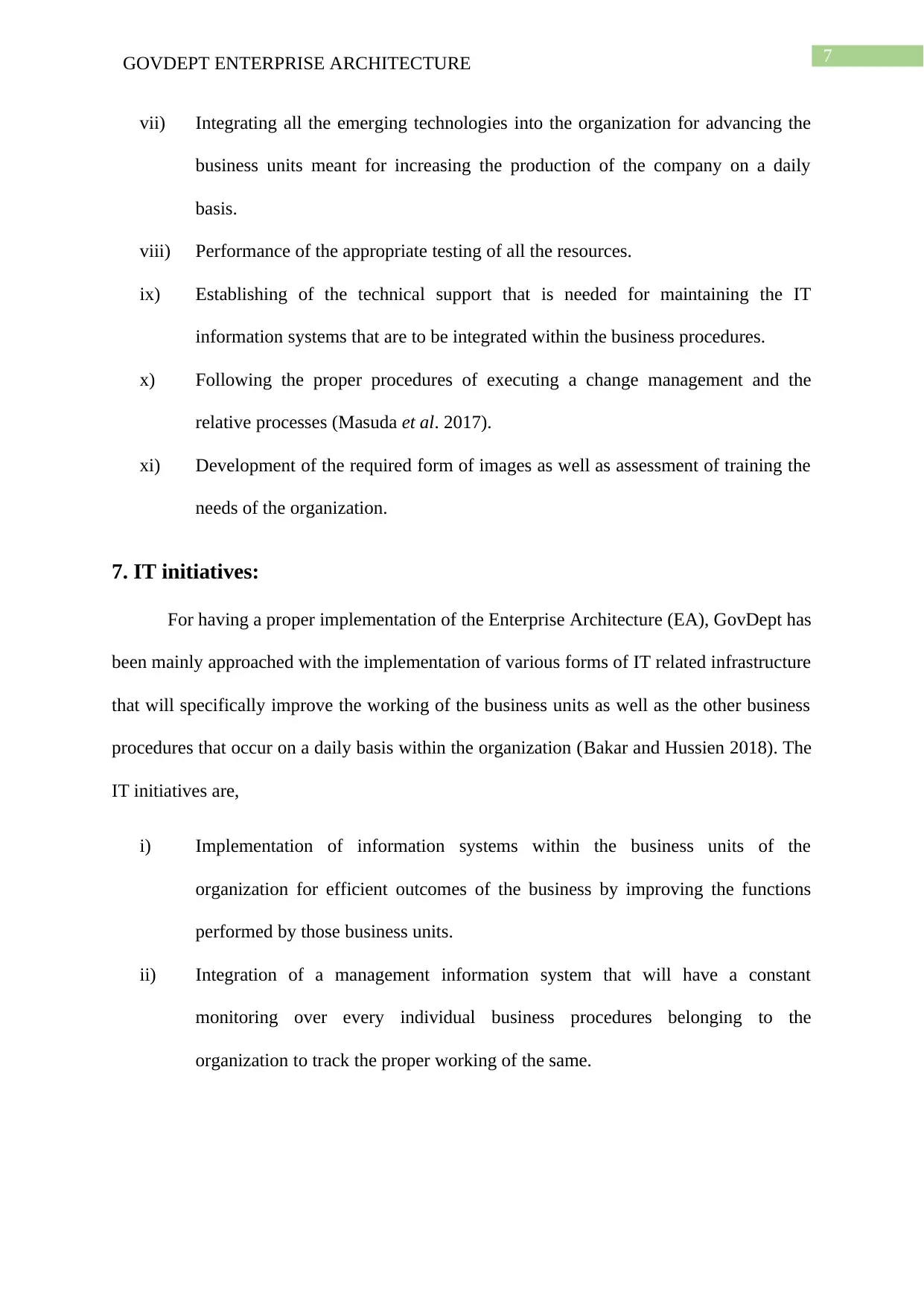
7GOVDEPT ENTERPRISE ARCHITECTURE
vii) Integrating all the emerging technologies into the organization for advancing the
business units meant for increasing the production of the company on a daily
basis.
viii) Performance of the appropriate testing of all the resources.
ix) Establishing of the technical support that is needed for maintaining the IT
information systems that are to be integrated within the business procedures.
x) Following the proper procedures of executing a change management and the
relative processes (Masuda et al. 2017).
xi) Development of the required form of images as well as assessment of training the
needs of the organization.
7. IT initiatives:
For having a proper implementation of the Enterprise Architecture (EA), GovDept has
been mainly approached with the implementation of various forms of IT related infrastructure
that will specifically improve the working of the business units as well as the other business
procedures that occur on a daily basis within the organization (Bakar and Hussien 2018). The
IT initiatives are,
i) Implementation of information systems within the business units of the
organization for efficient outcomes of the business by improving the functions
performed by those business units.
ii) Integration of a management information system that will have a constant
monitoring over every individual business procedures belonging to the
organization to track the proper working of the same.
vii) Integrating all the emerging technologies into the organization for advancing the
business units meant for increasing the production of the company on a daily
basis.
viii) Performance of the appropriate testing of all the resources.
ix) Establishing of the technical support that is needed for maintaining the IT
information systems that are to be integrated within the business procedures.
x) Following the proper procedures of executing a change management and the
relative processes (Masuda et al. 2017).
xi) Development of the required form of images as well as assessment of training the
needs of the organization.
7. IT initiatives:
For having a proper implementation of the Enterprise Architecture (EA), GovDept has
been mainly approached with the implementation of various forms of IT related infrastructure
that will specifically improve the working of the business units as well as the other business
procedures that occur on a daily basis within the organization (Bakar and Hussien 2018). The
IT initiatives are,
i) Implementation of information systems within the business units of the
organization for efficient outcomes of the business by improving the functions
performed by those business units.
ii) Integration of a management information system that will have a constant
monitoring over every individual business procedures belonging to the
organization to track the proper working of the same.
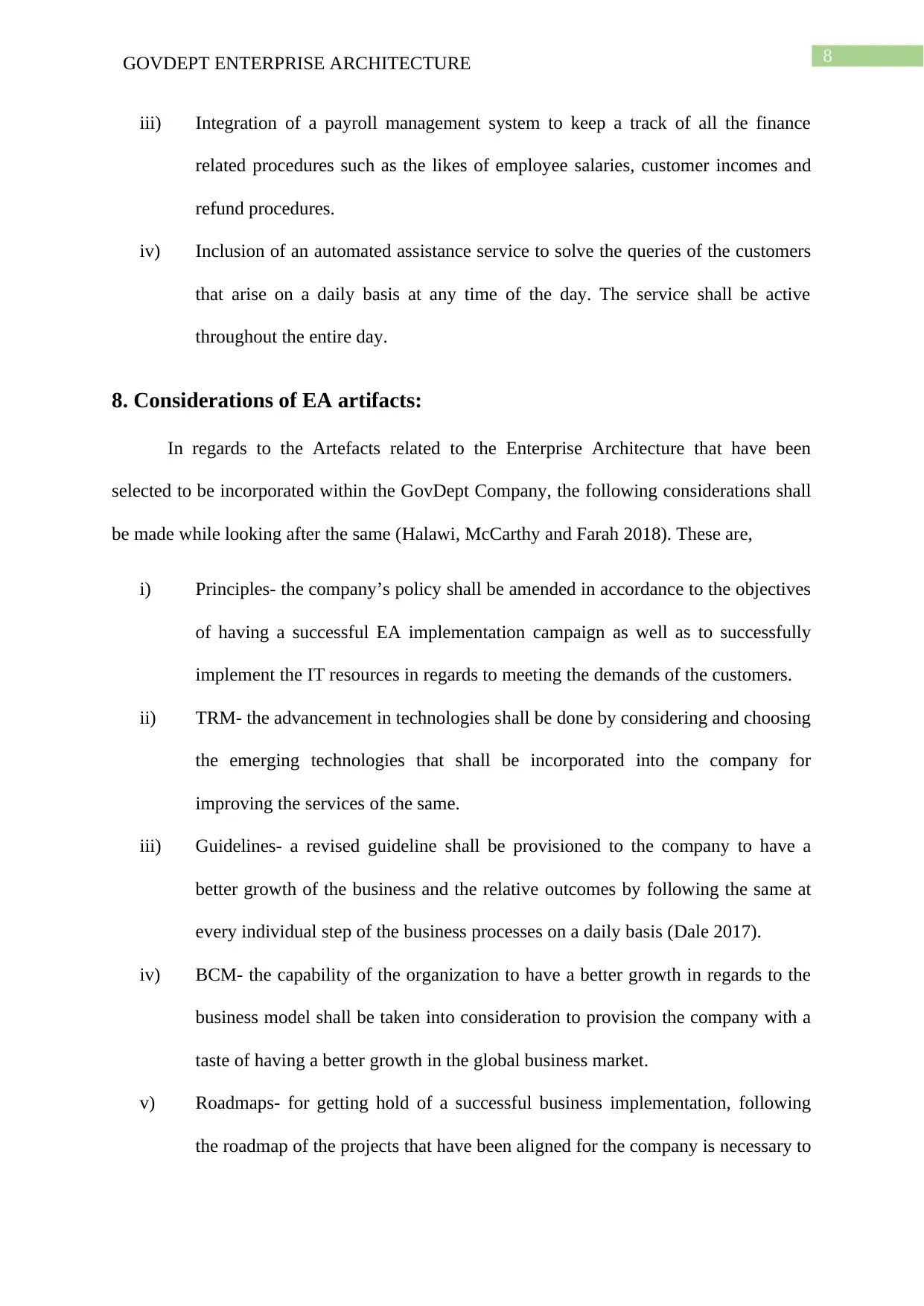
8GOVDEPT ENTERPRISE ARCHITECTURE
iii) Integration of a payroll management system to keep a track of all the finance
related procedures such as the likes of employee salaries, customer incomes and
refund procedures.
iv) Inclusion of an automated assistance service to solve the queries of the customers
that arise on a daily basis at any time of the day. The service shall be active
throughout the entire day.
8. Considerations of EA artifacts:
In regards to the Artefacts related to the Enterprise Architecture that have been
selected to be incorporated within the GovDept Company, the following considerations shall
be made while looking after the same (Halawi, McCarthy and Farah 2018). These are,
i) Principles- the company’s policy shall be amended in accordance to the objectives
of having a successful EA implementation campaign as well as to successfully
implement the IT resources in regards to meeting the demands of the customers.
ii) TRM- the advancement in technologies shall be done by considering and choosing
the emerging technologies that shall be incorporated into the company for
improving the services of the same.
iii) Guidelines- a revised guideline shall be provisioned to the company to have a
better growth of the business and the relative outcomes by following the same at
every individual step of the business processes on a daily basis (Dale 2017).
iv) BCM- the capability of the organization to have a better growth in regards to the
business model shall be taken into consideration to provision the company with a
taste of having a better growth in the global business market.
v) Roadmaps- for getting hold of a successful business implementation, following
the roadmap of the projects that have been aligned for the company is necessary to
iii) Integration of a payroll management system to keep a track of all the finance
related procedures such as the likes of employee salaries, customer incomes and
refund procedures.
iv) Inclusion of an automated assistance service to solve the queries of the customers
that arise on a daily basis at any time of the day. The service shall be active
throughout the entire day.
8. Considerations of EA artifacts:
In regards to the Artefacts related to the Enterprise Architecture that have been
selected to be incorporated within the GovDept Company, the following considerations shall
be made while looking after the same (Halawi, McCarthy and Farah 2018). These are,
i) Principles- the company’s policy shall be amended in accordance to the objectives
of having a successful EA implementation campaign as well as to successfully
implement the IT resources in regards to meeting the demands of the customers.
ii) TRM- the advancement in technologies shall be done by considering and choosing
the emerging technologies that shall be incorporated into the company for
improving the services of the same.
iii) Guidelines- a revised guideline shall be provisioned to the company to have a
better growth of the business and the relative outcomes by following the same at
every individual step of the business processes on a daily basis (Dale 2017).
iv) BCM- the capability of the organization to have a better growth in regards to the
business model shall be taken into consideration to provision the company with a
taste of having a better growth in the global business market.
v) Roadmaps- for getting hold of a successful business implementation, following
the roadmap of the projects that have been aligned for the company is necessary to
⊘ This is a preview!⊘
Do you want full access?
Subscribe today to unlock all pages.

Trusted by 1+ million students worldwide
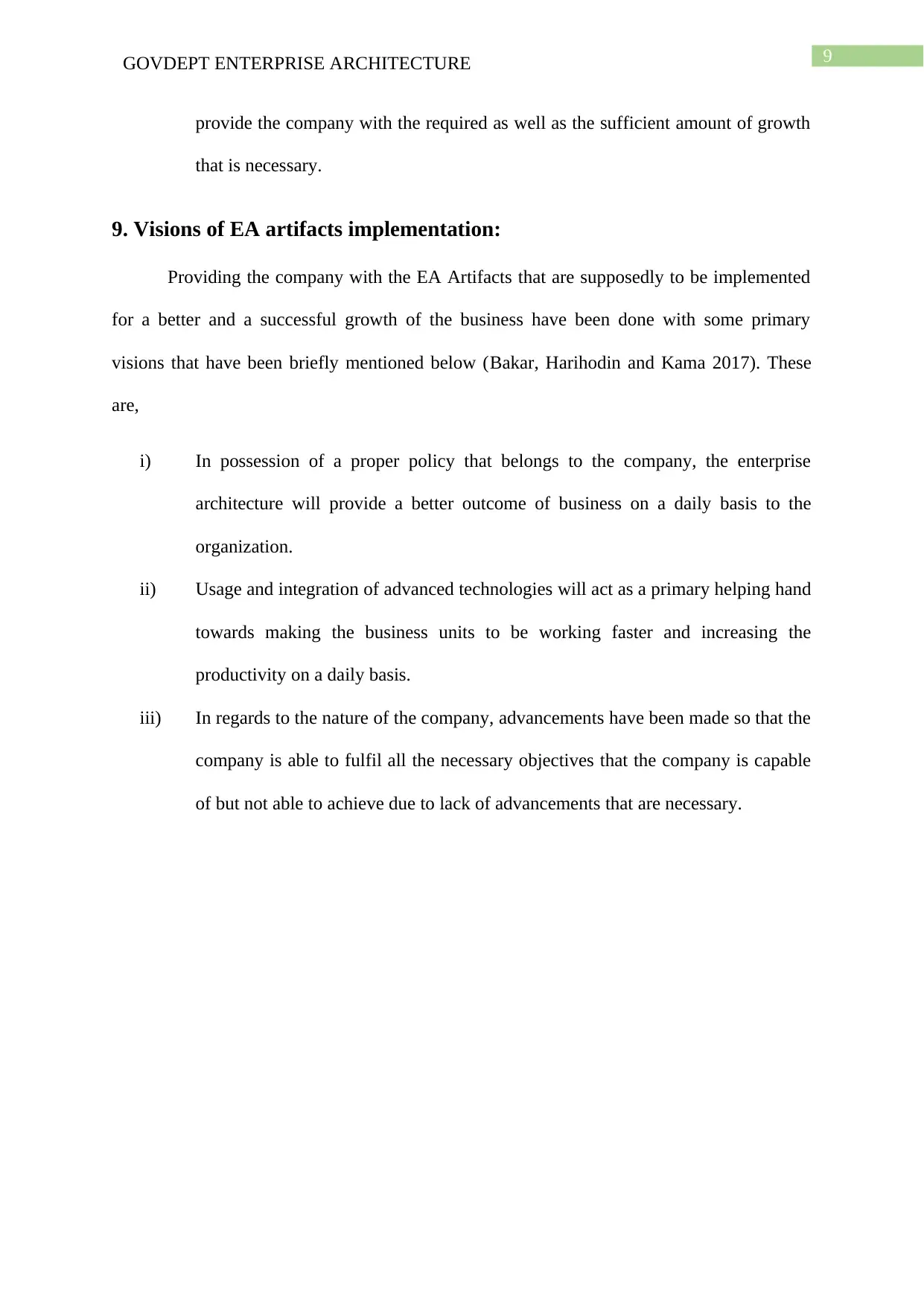
9GOVDEPT ENTERPRISE ARCHITECTURE
provide the company with the required as well as the sufficient amount of growth
that is necessary.
9. Visions of EA artifacts implementation:
Providing the company with the EA Artifacts that are supposedly to be implemented
for a better and a successful growth of the business have been done with some primary
visions that have been briefly mentioned below (Bakar, Harihodin and Kama 2017). These
are,
i) In possession of a proper policy that belongs to the company, the enterprise
architecture will provide a better outcome of business on a daily basis to the
organization.
ii) Usage and integration of advanced technologies will act as a primary helping hand
towards making the business units to be working faster and increasing the
productivity on a daily basis.
iii) In regards to the nature of the company, advancements have been made so that the
company is able to fulfil all the necessary objectives that the company is capable
of but not able to achieve due to lack of advancements that are necessary.
provide the company with the required as well as the sufficient amount of growth
that is necessary.
9. Visions of EA artifacts implementation:
Providing the company with the EA Artifacts that are supposedly to be implemented
for a better and a successful growth of the business have been done with some primary
visions that have been briefly mentioned below (Bakar, Harihodin and Kama 2017). These
are,
i) In possession of a proper policy that belongs to the company, the enterprise
architecture will provide a better outcome of business on a daily basis to the
organization.
ii) Usage and integration of advanced technologies will act as a primary helping hand
towards making the business units to be working faster and increasing the
productivity on a daily basis.
iii) In regards to the nature of the company, advancements have been made so that the
company is able to fulfil all the necessary objectives that the company is capable
of but not able to achieve due to lack of advancements that are necessary.
Paraphrase This Document
Need a fresh take? Get an instant paraphrase of this document with our AI Paraphraser
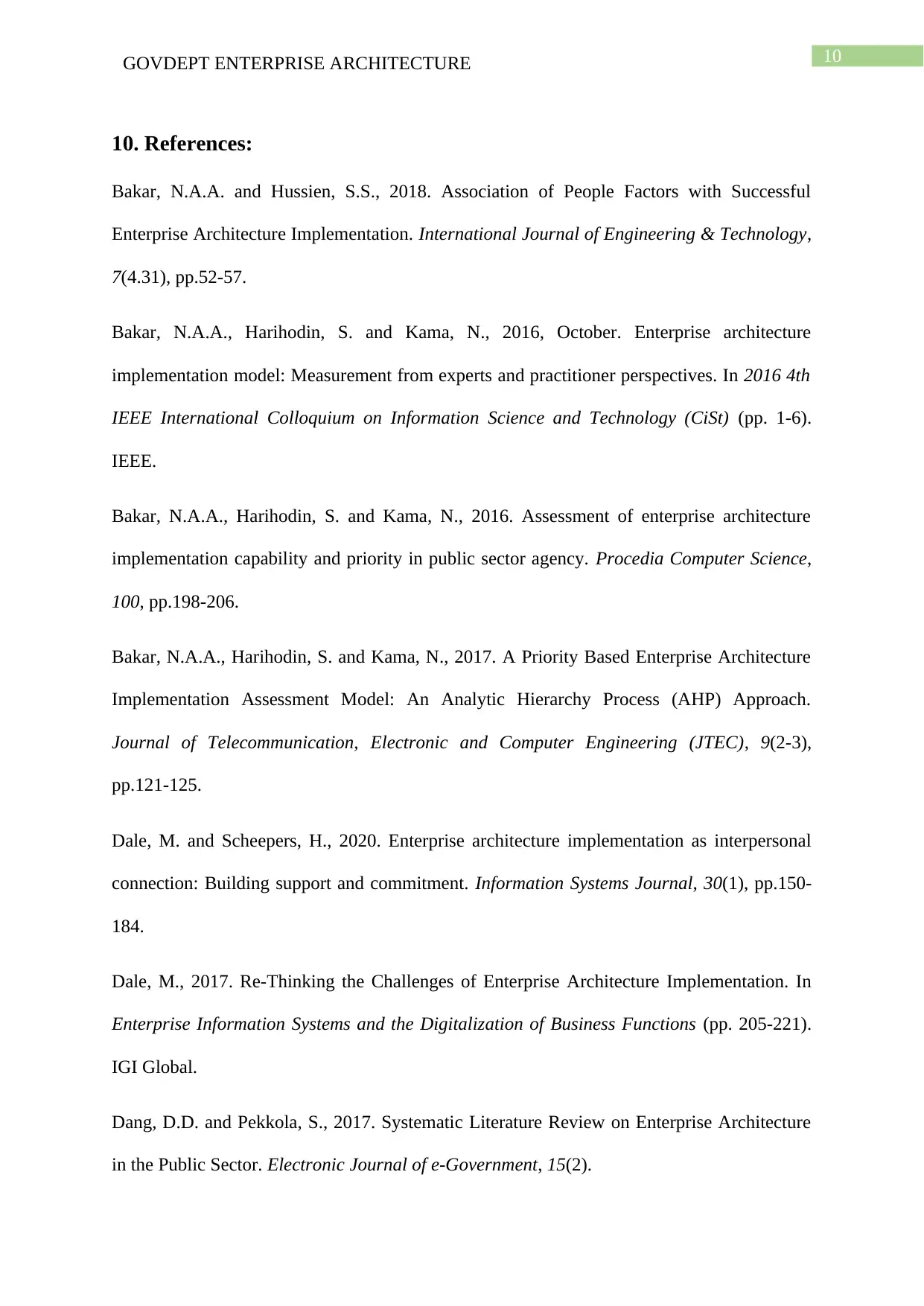
10GOVDEPT ENTERPRISE ARCHITECTURE
10. References:
Bakar, N.A.A. and Hussien, S.S., 2018. Association of People Factors with Successful
Enterprise Architecture Implementation. International Journal of Engineering & Technology,
7(4.31), pp.52-57.
Bakar, N.A.A., Harihodin, S. and Kama, N., 2016, October. Enterprise architecture
implementation model: Measurement from experts and practitioner perspectives. In 2016 4th
IEEE International Colloquium on Information Science and Technology (CiSt) (pp. 1-6).
IEEE.
Bakar, N.A.A., Harihodin, S. and Kama, N., 2016. Assessment of enterprise architecture
implementation capability and priority in public sector agency. Procedia Computer Science,
100, pp.198-206.
Bakar, N.A.A., Harihodin, S. and Kama, N., 2017. A Priority Based Enterprise Architecture
Implementation Assessment Model: An Analytic Hierarchy Process (AHP) Approach.
Journal of Telecommunication, Electronic and Computer Engineering (JTEC), 9(2-3),
pp.121-125.
Dale, M. and Scheepers, H., 2020. Enterprise architecture implementation as interpersonal
connection: Building support and commitment. Information Systems Journal, 30(1), pp.150-
184.
Dale, M., 2017. Re-Thinking the Challenges of Enterprise Architecture Implementation. In
Enterprise Information Systems and the Digitalization of Business Functions (pp. 205-221).
IGI Global.
Dang, D.D. and Pekkola, S., 2017. Systematic Literature Review on Enterprise Architecture
in the Public Sector. Electronic Journal of e-Government, 15(2).
10. References:
Bakar, N.A.A. and Hussien, S.S., 2018. Association of People Factors with Successful
Enterprise Architecture Implementation. International Journal of Engineering & Technology,
7(4.31), pp.52-57.
Bakar, N.A.A., Harihodin, S. and Kama, N., 2016, October. Enterprise architecture
implementation model: Measurement from experts and practitioner perspectives. In 2016 4th
IEEE International Colloquium on Information Science and Technology (CiSt) (pp. 1-6).
IEEE.
Bakar, N.A.A., Harihodin, S. and Kama, N., 2016. Assessment of enterprise architecture
implementation capability and priority in public sector agency. Procedia Computer Science,
100, pp.198-206.
Bakar, N.A.A., Harihodin, S. and Kama, N., 2017. A Priority Based Enterprise Architecture
Implementation Assessment Model: An Analytic Hierarchy Process (AHP) Approach.
Journal of Telecommunication, Electronic and Computer Engineering (JTEC), 9(2-3),
pp.121-125.
Dale, M. and Scheepers, H., 2020. Enterprise architecture implementation as interpersonal
connection: Building support and commitment. Information Systems Journal, 30(1), pp.150-
184.
Dale, M., 2017. Re-Thinking the Challenges of Enterprise Architecture Implementation. In
Enterprise Information Systems and the Digitalization of Business Functions (pp. 205-221).
IGI Global.
Dang, D.D. and Pekkola, S., 2017. Systematic Literature Review on Enterprise Architecture
in the Public Sector. Electronic Journal of e-Government, 15(2).
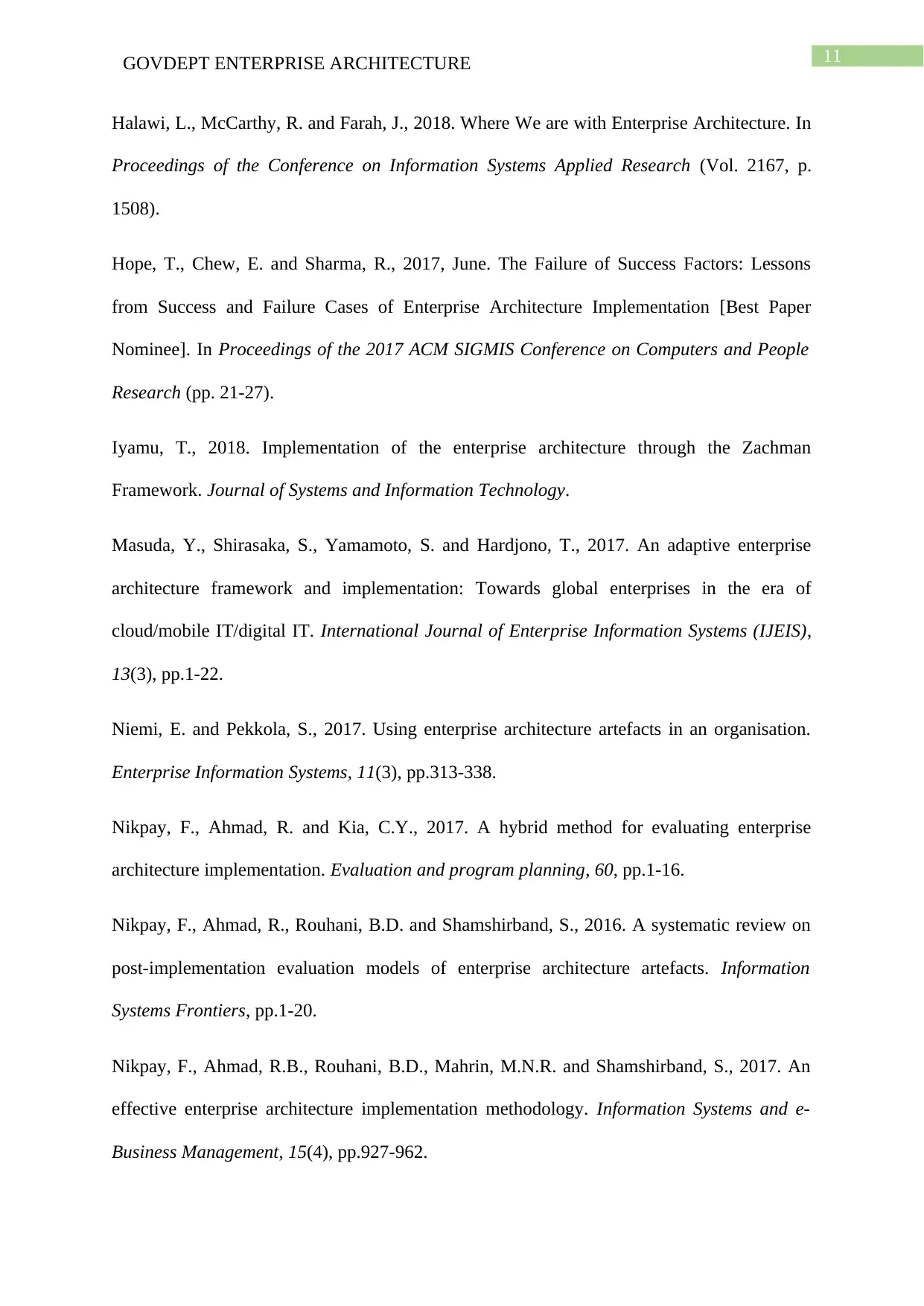
11GOVDEPT ENTERPRISE ARCHITECTURE
Halawi, L., McCarthy, R. and Farah, J., 2018. Where We are with Enterprise Architecture. In
Proceedings of the Conference on Information Systems Applied Research (Vol. 2167, p.
1508).
Hope, T., Chew, E. and Sharma, R., 2017, June. The Failure of Success Factors: Lessons
from Success and Failure Cases of Enterprise Architecture Implementation [Best Paper
Nominee]. In Proceedings of the 2017 ACM SIGMIS Conference on Computers and People
Research (pp. 21-27).
Iyamu, T., 2018. Implementation of the enterprise architecture through the Zachman
Framework. Journal of Systems and Information Technology.
Masuda, Y., Shirasaka, S., Yamamoto, S. and Hardjono, T., 2017. An adaptive enterprise
architecture framework and implementation: Towards global enterprises in the era of
cloud/mobile IT/digital IT. International Journal of Enterprise Information Systems (IJEIS),
13(3), pp.1-22.
Niemi, E. and Pekkola, S., 2017. Using enterprise architecture artefacts in an organisation.
Enterprise Information Systems, 11(3), pp.313-338.
Nikpay, F., Ahmad, R. and Kia, C.Y., 2017. A hybrid method for evaluating enterprise
architecture implementation. Evaluation and program planning, 60, pp.1-16.
Nikpay, F., Ahmad, R., Rouhani, B.D. and Shamshirband, S., 2016. A systematic review on
post-implementation evaluation models of enterprise architecture artefacts. Information
Systems Frontiers, pp.1-20.
Nikpay, F., Ahmad, R.B., Rouhani, B.D., Mahrin, M.N.R. and Shamshirband, S., 2017. An
effective enterprise architecture implementation methodology. Information Systems and e-
Business Management, 15(4), pp.927-962.
Halawi, L., McCarthy, R. and Farah, J., 2018. Where We are with Enterprise Architecture. In
Proceedings of the Conference on Information Systems Applied Research (Vol. 2167, p.
1508).
Hope, T., Chew, E. and Sharma, R., 2017, June. The Failure of Success Factors: Lessons
from Success and Failure Cases of Enterprise Architecture Implementation [Best Paper
Nominee]. In Proceedings of the 2017 ACM SIGMIS Conference on Computers and People
Research (pp. 21-27).
Iyamu, T., 2018. Implementation of the enterprise architecture through the Zachman
Framework. Journal of Systems and Information Technology.
Masuda, Y., Shirasaka, S., Yamamoto, S. and Hardjono, T., 2017. An adaptive enterprise
architecture framework and implementation: Towards global enterprises in the era of
cloud/mobile IT/digital IT. International Journal of Enterprise Information Systems (IJEIS),
13(3), pp.1-22.
Niemi, E. and Pekkola, S., 2017. Using enterprise architecture artefacts in an organisation.
Enterprise Information Systems, 11(3), pp.313-338.
Nikpay, F., Ahmad, R. and Kia, C.Y., 2017. A hybrid method for evaluating enterprise
architecture implementation. Evaluation and program planning, 60, pp.1-16.
Nikpay, F., Ahmad, R., Rouhani, B.D. and Shamshirband, S., 2016. A systematic review on
post-implementation evaluation models of enterprise architecture artefacts. Information
Systems Frontiers, pp.1-20.
Nikpay, F., Ahmad, R.B., Rouhani, B.D., Mahrin, M.N.R. and Shamshirband, S., 2017. An
effective enterprise architecture implementation methodology. Information Systems and e-
Business Management, 15(4), pp.927-962.
⊘ This is a preview!⊘
Do you want full access?
Subscribe today to unlock all pages.

Trusted by 1+ million students worldwide
1 out of 13
Related Documents
Your All-in-One AI-Powered Toolkit for Academic Success.
+13062052269
info@desklib.com
Available 24*7 on WhatsApp / Email
![[object Object]](/_next/static/media/star-bottom.7253800d.svg)
Unlock your academic potential
Copyright © 2020–2025 A2Z Services. All Rights Reserved. Developed and managed by ZUCOL.





